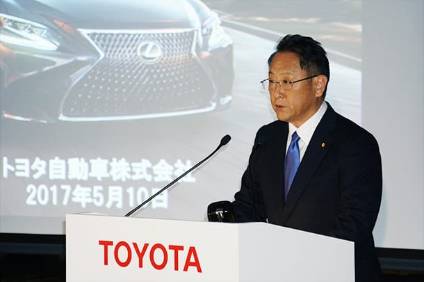
After posting a 30% decline to operating income in the fiscal year ended March 31, Toyota is forecasting a further 20% decline in the current fiscal year.
Operating income for the year ended March 31 decreased from 2.8539 trillion yen to 1.9943 trillion yen, while income before income taxes was 2.1938 trillion yen. Net income decreased from 2.3126 trillion yen to 1.8311 trillion yen.

Discover B2B Marketing That Performs
Combine business intelligence and editorial excellence to reach engaged professionals across 36 leading media platforms.
Toyota’s results are being impacted by the strong yen and increased costs to sales in key markets, particularly the US, where industry demand has hit a plateau and OEM incentives have risen. In 2015, the exchange rate averaged around 120 yen to the dollar. In the fiscal year just ended, the average was 108 and Toyota expects the dollar to trade at about 105 yen on average this fiscal year.
Consolidated vehicle sales in the fiscal year ended March 31 totalled 8,970,860 units, an increase of 289,532 units compared to the previous fiscal year.
For the fiscal year ending March 31, 2018, Toyota estimates that consolidated vehicles sales will be 8.9m units – slightly down on the previous year.
Commenting on the operating income result, Toyota executive vice president Osamu Nagata said: “Excluding the overall impact of foreign exchange rates and swap valuation gains and losses, operating income improved by 120 billion yen year on year, as a result of profit improvement activities throughout the year.”
In Japan, vehicle sales in the year ended March 31 totalled 2,273,962 units, an increase of 214,869 units. Operating income, excluding the impact of valuation gains/losses from interest rate swaps, decreased by 470.7 billion yen to 1.206 trillion yen.
In North America, vehicle sales totalled 2,837,334 units, a decrease of 1,895 units. Operating income, excluding the impact of valuation gains/losses from interest rate swaps, decreased by 174.7 billion yen to 330.9 billion yen.
In Europe, vehicle sales totalled 924,560 units, an increase of 80,148 units. Operating income, excluding the impact of valuation gains/losses from interest rate swaps, decreased by 87.6 billion yen to a loss of 11.8 billion yen.
In Asia, vehicle sales totalled 1,587,822 units, an increase of 242,986 units. Operating income, excluding the impact of valuation gains/losses from interest rate swaps, decreased by 30.5 billion yen to 424.4 billion yen.
Toyota forecasts consolidated net revenue of 27.5 trillion yen in the fiscal year ended March 31, 2018, operating income of 1.6 trillion yen and net income of 1.5 trillion yen, based on an exchange rate of 105 yen to the U.S. dollar and 115 yen to the euro.
In a prepared statement issued with the latest financial results, Toyota President Akio Toyoda highlighted strategic shifts at the company, including its latest engineering strategy.
“When it comes to making ever-better cars, our challenge of making cars in a completely new way by introducing TNGA (Toyota New Global Architecture) has manifested in the new Prius PHV and the C-HR new compact SUV, meaning we are now able to deliver TNGA-based vehicles to our customers.
“I realise now that, through TNGA, our efforts to make ever-better cars have started to take root as an unshakable axis that penetrates our technological development, production engineering and production sites,” he said.
He maintains that Toyota is finally shaking off its ‘boring cars’ reputation.
“Until now, there were times when Toyota’s cars were called ‘boring’ or were said to be lacking in character. But I now feel that, in terms of driving and design, our customers have begun to favourably evaluate our cars.”
However, he acknowledged that the company can become more efficient.
“On the other hand, when it comes to making ever-better cars in a smart way, it is becoming apparent that there is still room for improvement,” he said.
“For example, might it not be the case that an over-enthusiastic desire to make ever-better cars is putting priority on improving our competitiveness in terms of performance and quality, while leaving issues of cost and lead time for later?
“Or, is the way we work capable of thoroughly implementing the basic principle of “appropriate sales price minus appropriate profit equals ideal cost”?
“In other words, I feel a strong sense of crisis about whether or not we are actually executing car-making from the perspective of the customer in all Toyota workplaces – from development, production, procurement and sales, all the way to administrative divisions.”






